
Original Link: https://www.anandtech.com/show/1605
DFI nForce4: SLI and Ultra for Mad Overclockers
by Wesley Fink on February 5, 2005 9:30 AM EST- Posted in
- Motherboards
DFI has performed a miraculous change of marketing directions in the past two years. They have moved from a solid second tier motherboard manufacturer producing nice OEM motherboards and a few solid, but dull, branded motherboards to a company whose products have come to define the Computer Enthusiast market. We can all chuckle when we say that Diamond Flower International became Designed For Innovation to fit their new image, but the transition is truly that remarkable.
A quick visit to www.xtremesystems.org or any other site devoted to enthusiasts who live to top the orb at Futuremark will find huge discussions of each little feature of upcoming DFI motherboards. Now, enthusiasts seem to ask with each new motherboard review, "That's fine, but what will the coming DFI do?" The DFI Socket 754 nF3 250Gb was one of the last 754 boards to market, but it was so heavily anticipated that DFI pre-sales totaled several months of production even before the board landed on the market.
This time around, the new nForce4 boards from DFI are some of the first to market, surely a first for DFI, and the new boards have already created quite a buzz when it was found that their new nF4 Ultra board, with two x16 PCIe slots, could be modded easily into an nForce4 SLI by closing a bridge on the nF4 Ultra chipset. Suddenly, a $140 motherboard could deliver everything that a full SLI board could deliver with a simple mod using a #2 pencil. Details of that mod are at Morphing nForce4 Ultra into nForce4 SLI. Add to that the incredible range of tweaking controls, which are becoming trademark DFI, and enthusiasts have been lining up to buy the new DFI nForce4 boards, which should actually be available right now.
There are two new DFI nForce4 boards covered in this review - the full-blown LANParty nF4 SLI-DR and the LANParty UT nF4 Ultra-D. However, the boards are basically the same and built on the same PCB. The LANParty is based on the nVidia nForce4 SLI chipset, while the UT has a few less features and is based on the nForce4 Ultra chipset. However, both boards sport 2 x16 PCIe slots, both boards perform the same, and they even use the same BIOS. As we found in the Ultra to SLI mod article, the UT board becomes, in every way, an SLI board after the simple mod. We will talk about the few differences between the boards in this review, but all benchmarking, overclocking, and memory performance tests apply equally to both boards.
DFI wanted to be certain that buyers of the lower-priced UT Ultra board still had all the overclocking controls and options available on the full-blown LANParty, and in this case, it is not just lip service. The SLI and Ultra boards can be considered equal in performance. The full-blown LANParty package with SLI adds a few more features to justify the $60 premium that the LANParty SLI will ask.
UPDATE 2/05/2005: nVidia has acted to prevent, or at least make it more difficult, to mod the Ultra board to SLI. First, DFI has advised us, and posted on their website, that they will NOT sell the SLI bridge to buyers of the Ultra board. Second, nVidia has advised us that future shipments of the Ultra chipset have been modified so that the mod to SLI will no longer be possible. An additional side effect of this second action is that the "Dual Video" mode, which performs at about 90% of SLI performance levels, will only work with nVidia SLI drivers 66.75 or earlier. If you do a quick check of web driver postings you will see it is now very difficult to find 66.75 drivers. With a chipset modded to SLI the "Dual Video" mode worked through 70.xx versions of the nVidia driver. nVidia also made it clear they will continue to make driver changes to prevent functioning of any "non-standard" (8X/8X) operation of their SLI driver. This also throws into question whether the VIA "dual graphics" mode on the 894 Pro chipset will ever work with nVidia graphics cards. If you are interested in the current UT Ultra-D we suggest you buy one now if you can find it. Future versions of the UT Ultra-D will not have the same capabilities as a result of these actions.
Basic Features: DFI nForce4
DFI uses the same PCB for all nForce4 models. This assures that the overclocking capabilities of all the nForce4 boards are the same. In fact, all boards use the same BIOS. The 3 DFI nForce4 models are:- LANParty nF4 SLI-DR
- LANParty UT nF4 SLI-D
- LANParty UT nF4 Ultra-D
Models with the SLI name feature the nVidia nForce4 SLI chipset, while those with Ultra use the nF4 Ultra chipset. All boards feature dual PCIe slots, and the "R" in the SLI-DR adds Silicon Image 3114 4-drive SATA RAID. The two LANParty UT models are identical except one uses the SLI Chipset and the other uses nF4 Ultra.

We tested production models of the top and bottom of the DFI nForce4 lineup, and we can report that performance of these two models was exactly the same in all our benchmarks. Your choice, therefore, should be based on the SLI/Ultra choice and other features. In addition, those who are willing to mod a chip can make a minor change to the $140 Ultra-D board and convert it into an SLI chipset with SLI performance identical to the top line SLI boards. Details on this mod are available at Morphing nForce4 Ultra into nForce4 SLI.
| Specification | DFI LANParty nF4 SLI-DR | DFI LANParty UT nF4 Ultra-D |
| CPU Interface | Socket 939 Athlon 64 | |
| Chipset | nForce4 SLI (single chip) | nForce4 Ultra (single chip) |
| Bus Speeds | 200MHz to 456MHz (in 1MHz increments) | |
| PCI/AGP Speeds | Asynchronous (Fixed) | |
| PCI Express | 100MHz to 145MHz in 1MHz increments | |
| Core Voltage | Auto, 0.8V to 1.55V in 0.025V increments (Normal) PLUS *104%, 110%, 113%, 123%, 126%, 133%, 136% (Special - to 2.1V) |
|
| CPU Startup Voltage | Startup, 0.825V to 1.550V in 0.025V increments | |
| DRAM Voltage | 2.5V to 3.2V in 0.1V increments (3V jumper) 2.5V to 4.0V in 0.1V increments (5V jumper) |
|
| Chipset Voltage | 1.5V, 1.6V, 1.7V, 1.8V | |
| Hyper Transport Ratios | Auto, 1.0, 1.5, 2.0, 2.5, 3.0, 4.0, 5.0 | |
| LDT Bus Transter | 16/16, 16/8, 8/16, 8/8 | |
| LDT Voltage | 1.2V, 1.3V, 1.4V, 1.5V | |
| CPU Ratios | Auto, 4x to 25x in 0.5x increments | |
| Cool'n'Quiet MAX FID | Auto, 8.0 to 13.0 in 0.5x increments | |
| DRAM Speeds | Auto, 100, 120, 133, 140, 150, 166, 180, 200 | |
| Memory Command Rate | Auto, 1T, 2T | |
| Memory Slots | Four 184-pin DDR Dual-Channel Slots Unbuffered ECC or non-ECC Memory to 4GB Total |
|
| Expansion Slots | 2 x16 PCIe Slots 1 x4 PCIe 1 x1 PCIe 2 PCI Slots |
|
| Onboard SATA | 4-Drive SATA by nF4 PLUS 4-Drive SATA by Sil31144-Drive SATA by nF4 |
|
| Onboard IDE | Two Standard nVidia ATA133/100/66 (4 drives) | |
| SATA/IDE RAID | 4-Drive SATA PLUS 4-Drive IDE (8 total) Can be combined in RAID 0, 1 PLUS 4-Drive SATA by Sil3114 Sil3114 Raid 0, 1, 5 |
4-Drive SATA PLUS 4-Drive IDE (8 total) Can be combined in RAID 0, 1 |
| Onboard USB 2.0 IEEE-1394 | 10 USB 2.0 ports supported nF4 2 1394A FireWire ports by VIA VT6307 |
|
| Onboard LAN | Dual Gigabit Ethernet PCIe by Vitesse VSC8201 PHY PCI by Marvel 88E8001 |
|
| Onboard Audio | Karajan Audio Module based on Realtek ALC850 8-Channel codec with 6 UAJ audio jacks, CD-in, front audio, and coaxial SPDIF In and Out |
|
| Other Features | Power and Reset momentary switches | |
| BIOS | Award 2/01/2005 | |
All of the new DFI boards are based on either the nForce4 SLI or the nForce4 Ultra. More information on nForce4 is available at:
Morphing nForce4 Ultra into nForce4 SLI
NVIDIA's GeForce 6 SLI: Demolishing Performance Barriers
FIRST LOOK: Gigabyte K8NXP-SLI
FIRST LOOK - nForce4: Gigabyte K8NXP-9
nForce4: PCI Express and SLI for Athlon 64
NVIDIA SLI Performance Preview with MSI's nForce4 SLI Motherboard
The DFI boards all support the full range of nVidia nForce4 features including nVRAID, Active Armor, SATAII 3Gb/s drives, NCQ, any-drive IDE/SATA Raid, PCIe Gigabit LAN by a PHY Ethernet chip (plus an additional PCI Gigabit LAN), and the nTune utility.
Packaging for the full LANParty nF4 SLI-DR is typical LANParty.
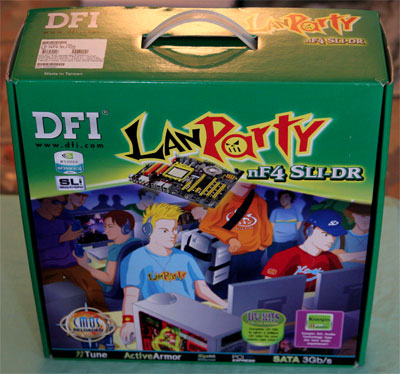
It is a huge package with a motherboard, UV cables, a system carrier, a Front-X box, and even UV sheathing for your system cables.
The UT provides a more modest package.
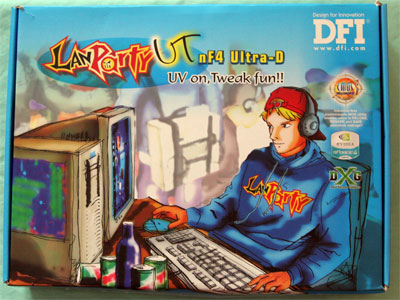
The UT does include most of the same features and accessories found in the LANParty SLI-DR, however. The board is the same except it is based on the Ultra chipset instead of SLI and the Ultra-D does not have the additional 4 SATA ports provided by the Silicon Image 3114. You still get the UV cables, and even the same Karajan Audio Module. The missing accessories are the system carrier, Front-X (which will be very important to some) and cable sheathing. If performance is what matters to you, then you can choose any of the new DFI nForce4 boards and then decide what additional features and accessories matter to you.
DFI has continued with the Karajan Audio Module first introduced on their LANP arty 925x. However, we wish that DFI had been able to use the High Definition ALC880 or a similar chip instead of the more common ALC850. The Karajan Module isolates audio for best signal-to-noise ratio and high definition chip benefits most from this isolation.
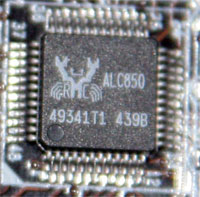
The Realtek ALC850 7.1 audio chip has appeared on many recent motherboards. This 8-channel audio codec is fully AC '97 2.3 compliant and features 16-bit 8-channel audio and auto-jack sensing with support for a full range of analog and digital IO. The Karajan Module includes both SPDIF in and out coaxial connectors on the rear IO panel. There is also an on-board SPDIF connector for an optical cable.
The ALC850 Codec provides four pairs of stereo outputs, with 5-Bit volume controls and multiple stereo and mono inputs, along with flexible mixing, and gain and mute functions. Two 50mW/20ohm headset audio amplifiers are integrated at Front-Out and Surround-Out, and both amplifiers are selectable for Front-Out, Line-In and Mic-In as a Universal Audio Jack.
You can find more information on the recently released ALC850 atRealtek.

DFI provides a full selection of rear I/O ports. These include 6 programmable audio mini jacks plus coaxial SPDIF in and out connectors to support the Realtek ALC850. The back panel also includes PS2 mouse and keyboard, 1 standard Firewire (IEEE1394a), 6 USB, and two RJ45 Gigabit Ethernet. There are no rear ports for a Parallel Printer or serial devices, but there is an onboard header for an external serial device - an IR header.

On "R" models, like the DFI LANParty nF4 SLI-DR, DFI uses the Silicon Image 3114 SATA controller to add 4 more SATA ports to the 4 already provided by the nVidia nForce4 chipset. The Sil3114 ports can be combined in RAID 0, 1, or 5. RAID 5 can be implemented on this controller with 3 hard drives.
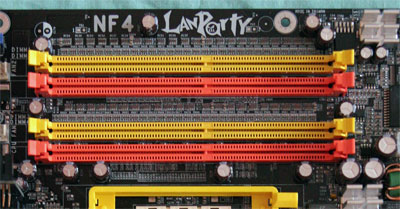
The four DIMM slots support up to 4GB of up to DDR400 memory in a Dual-Channel memory configuration. Dual-Channel 1 is DIMMs 1 and 3, and Dual-Channel 2 is DIMMs 2 and 4. DFI specifies support for both ECC and non-ECC unbuffered memory. Contacts at DFI advise that best overclocking is achieved with the dual-channel DIMMs in Sockets 2 and 4.
Board Layout: DFI nForce4
Each new generation of DFI motherboards seem to be improving on board design, and the DFI nForce4 boards feature a very functional layout.
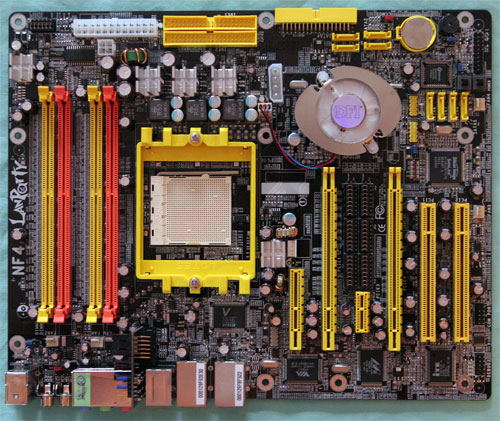
The DFI nF4 places the CPU in the top center of the board and DIMMs at the top. This arrangement worked well in our testing and should work better for those who change memory frequently than the crowded right edge location used on most boards.
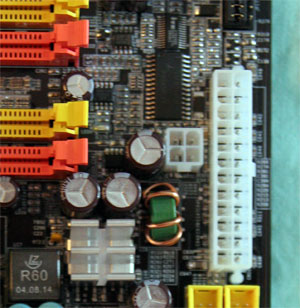
The ATX 24-pin and the 4-pin 12V connector are in ideal locations on the DFI nF4. The bulky 24-pin ATX is located on the preferred top right edge of the motherboard, and the 4-pin 12V power connector is right beside it. This board-edge location keeps bulky cables away from the CPU and memory.
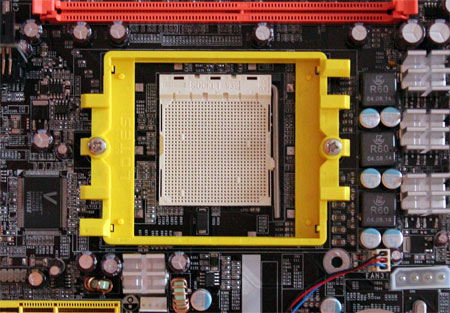
The CPU socket is in the top center of the board. PCI slots are below the socket and memory is above the CPU. There is plenty of room around the Socket 939, so most Heatsink/Fans should work fine. A Zalman 7000 overhung DIMM slot 4, but it still cleared our stock OCZ memory and dimms could work in all slots.
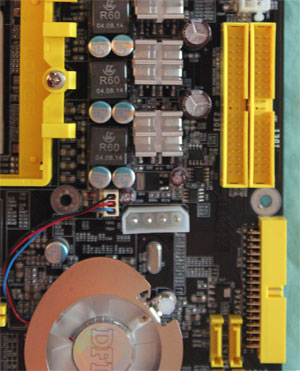
The IDE connectors are at our preferred upper right edge of the motherboard, and the floppy connector is a board edge connector about right midline of the board. Both locations are nearly ideal and worked well in our testing. If you use a floppy drive, you might want to connect the floppy before screwing down the board, as many mid-tower cases are tight in the area of the floppy connector. Having said that, we would still choose this floppy location any day over the floppy placed at the bottom of the board.

SATA connectors are to the right of the nF4 chipset and the magnetic levitation fan. The fan is low enough for video cards - both ATI and nVidia - to mount properly. We tried both ATI and nVidia top-of-the line cards to make sure.

Most competitive boards with 2 x16 PCIe video slots use a simple card edge selector that is reversed for SLI operation. DFI uses 6 jumper blocks that must all be moved to switch to SLI mode.
DFI also continues CMOS reloaded, which was introduced with the second generation LANParty boards. This feature allows you to save several different custom BIOS set-ups so that you can recall custom BIOS settings easily for a particular overclock or settings for a different OS. Overclockers and users who run multiple operating systems will really find CMOS Reloaded to be a useful feature.
Overclocking: DFI nForce4
With DFI's reputation as an overclocker's board, and the incredible range of tweaking options available in the BIOS, everyone is expecting incredible overclocking performance with the new DFI nForce4 boards. They will definitely not be disappointed.
| Front Side Bus Overclocking Testbed | |
| Processor: | Athlon 64 4000+ (2.4GHz, 1MB Cache) |
| CPU Voltage: | 1.55V (default 1.50V) |
| Cooling: | Thermaltake Silent Boost K8 Heatsink/Fan |
| Power Supply: | OCZ Power Stream 520W |
| Memory: | OCZ PC3200 EL Platinum Rev. 2 (Samsung TCCD Memory Chips) |
| Hard Drive: | Seagate 120GB 7200RPM IDE 8MB Cache |
| Maximum OC: (Standard Ratio) |
238x12 (Auto HT, 2-3-2-7, 1T, 2.9V) 2856MHz (+19%) |
| Maximum FSB: (Lower Ratio) |
318x9 (2862MHz) (Auto HT, 2.5-4-3-7, 2.9V) (1:1 Memory, 1T, 2 DIMMs in DC mode) (+59% Bus Overclock) |
The DFI nForce4 boards shredded all previous records with this CPU and memory - reaching the highest overclocks at stock speed and at a lower mulitiplier that we have ever tested with this combination. We have squeaked by the 300 CPU clock frequency (DDR600) in the past, but it always required a 2T command rate. This time, we reached an astounding 318 (DDR636) at 1T, at the rather aggressive memory timings of 2.5-4-3-7 with our standard OCZ PC3200 Platinum Rev.2, which is based on Samsung TCCD chips. This is the highest DDR speed that we have ever reached with this memory or any other double-sided DDR memory.
What impact does 318 have on performance? Quake 3 ran at 642FPS and SiSoft Sandra 2004 standard memory bandwidth was 8,300 MB/s. The Sandra unbuffered memory bandwidth was at 4000 MB/s. All these results are new performance records in our memory testing. The very wide range of memory voltages to 4.0V is particularly useful in reaching the highest possible overclocks, along with a very complete set of memory tweaking options in the BIOS. There is still a huge reserve in the available memory voltage range as we only needed 2.9V to reach these performance levels. Those with exotic cooling will appreciate that the CPU voltage and memory voltage settings on the DFI will give them what they need to squeeze every bit of performance from their CPU and memory.
DFI delayed final release of both nForce4 boards to update some 20 components on the board and to make further modifications to BIOS timings. The goal was to improve memory compatibility and further improve the already stellar overclocking abilities of the engineering sample. Compared to the engineering sample board that we tested, the final retail board is a much better overclocker. The update certainly appears to be a success, and DFI tells us that all retail boards, the boards coming off the line, have the modifications and new BIOS.
Memory Stress Testing
Optimum tRAS
In past reviews, memory bandwidth tests established that a tRAS of 10 was optimal for the nForce3 chipset and a tRAS setting of 11 or 12 was generally best for nForce2. Since this was the first memory stress test of a production nForce4 board, tRAS timings were first tested with memtest86, a free diagnostic program with its own boot OS that will boot from either a floppy disk or optical disk. Bandwidth was measured from tRAS 5 to tRAS 11 to determine the best setting.
| Memtest86 Bandwidth DFI nForce4 with Athlon64 4000+ |
|
| 5 tRAS | 2191 |
| 6 tRAS | 2242 |
| 7 tRAS | 2242 |
| 8 tRAS | 2242 |
| 9 tRAS | 2141 |
| 10 tRAS | 2141 |
| 11 tRAS | 2092 |
The best bandwidth was achieved in the 6 to 8 range with this combination of nForce4 and the 4000+, so a mid-value tRAS of 7 was chosen for all tests.
Memory Stress Tests
Our memory stress test measures the ability of the DFI to operate at its officially supported memory frequency (400MHz DDR), at the lowest memory timings that OCZ PC3200 Platinum Rev. 2 modules will support. All DIMMs used for stress testing were 512MB double-sided (or double-bank) memory. To make sure that memory performed properly in Dual-Channel mode, memory was only tested using either one dual-channel (2 DIMMs) or 2 dual-channels (4 DIMMs).
| Stable DDR400 Timings - One Dual-Channel (2/4 DIMMs populated) |
|
| Clock Speed: | 200MHz |
| CAS Latency: | 2 |
| RAS to CAS Delay: | 2T |
| RAS Precharge: | 7T |
| Precharge Delay: | 2T |
| Command Rate: | 1T |
Using two DIMMs in Dual-Channel 128-bit mode, the memory performed in all benchmarks at the fastest 2-2-2-7 timings, at default 2.6V voltage.
Tests with 4 DS DIMMs on an AMD Athlon 64 system are more demanding, since AMD specifies DDR333 for this combination. However, most AMD Athlon 64 motherboards combined with recent AMD processors (the memory controller is on the AMD CPU) have been able to handle 4 DIMMs at DDR400.
| Stable DDR400 Timings - 4 DIMMs (4/4 DIMMs populated) |
|
| Clock Speed: | 200MHz |
| CAS Latency: | 2.0 |
| RAS to CAS Delay: | 2T |
| RAS Precharge: | 7T |
| Precharge Delay: | 2T |
| Command Rate: | 2T |
Tests with all four DIMM slots populated on the DFI nForce4 boards required a 2T Command Rate with 4 DS DIMMs in two dual channels. This is the pattern seen on other top-performing Socket 939 boards, but we hoped that higher voltage might allow us to eek out 4 DS DIMM 1T performance. However, additional voltage did not help and DDR400 with 4DS DIMMs still required a 2T Command Rate on the DFI nForce4 boards.
Test Setup
| Performance Test Configuration | |
| Processor(s): | AMD Athlon 64 4000+ (2.4GHz) Socket 939 |
| RAM: | 2 x 512MB OCZ PC3200 Platinum Rev. 2 |
| Hard Drive(s): | Seagate 120GB 7200 RPM IDE (8MB Buffer) |
| Video AGP & IDE Bus Master Drivers: | nVidia nForce 6.31 (nForce4 SLI) SiS 1.17e VIA 4in1 Hyperion 4.51 (12-02-2003) nVidia nForce Platform Driver 4.24 (nForce3 Ultra) |
| Video Card(s): | nVidia 6800 Ultra (AGP 8X) nVidia 6800 Ultra (PCI Express) |
| Video Drivers: | nVidia nForce 61.77 (SiS, VIA, nF3U, Intel 925X) nVidia nForce 71.40 Beta (nForce4) |
| Operating System(s): | Windows XP Professional SP1 |
| Motherboards: | DFI LANParty nF4 SLI-DR DFI LANParty UT nF4 Ultra-D Winfast 755FXK8AA (SiS 755FX) Soltek K8TPro-939 (VIA K8T800 PRO) Epox 9NDA3+ (nForce3 Ultra) nVidia nForce4 Ultra Reference Board Abit AV8 PRO (VIA K8T800 PRO) ECS KV2 Extreme (VIA K8T800 PRO) Gigabyte K8NSNXP-939 (nVidia nForce3 Ultra) MSI K8N Neo2 (nVidia nForce3 Ultra) MSI K8T Neo2 (VIA K8T800 PRO) |
Tests used OCZ PC3200 Platinum Rev. 2, which uses Samsung TCCD chips. All memory ran at 2-2-2-7 timing in benchmarks on the DFI nForce4 boards.
The nVidia 6800 Ultra AGP was used for testing in all 939 chipsets other than nForce4. The PCI Express 6800 Ultra was used for all testing with the nForce4 and the Reference Intel 925X. Resolution in all benchmarks is 1024x768x32 unless noted otherwise.
Results for the DFI nForce4 boards are color-coded red in all graphs. VIA K8T800 Pro based motherboards are in green in our results, and nVidia nForce4/nForce3 are in orange. Results for the SiS 755FX based Winfast are yellow in all graphs. Intel results are included for Reference only and are blue in the graphs. The color coding should allow easy comparison of the tested DFI nF4 to other nF4/nF3 results and to other chipsets and processors.
General Performance & Encoding
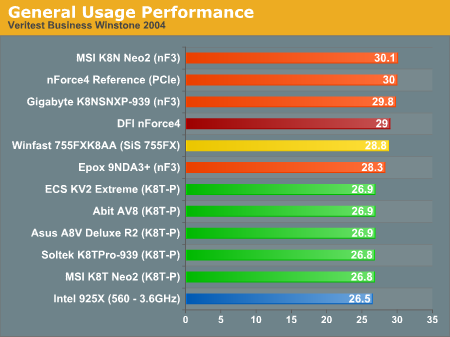

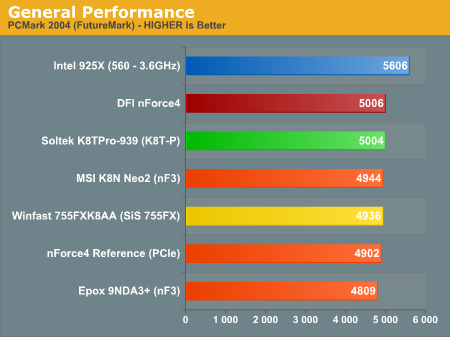
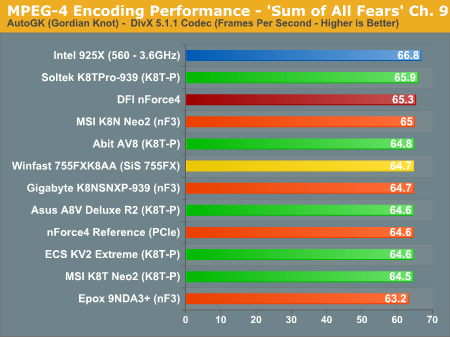
The DFI nForce4 is competitive with other Athlon 64 boards in Business and Multi-Media Winstones, but it is hardly a standout performer as it is in gaming benchmarks. The DFI does, however, perform exceptionally well compared to the nForce4 Reference and other Athlon 64 boards in PCMark 2004 and the 2-pass Auto GK Media Encoding benchmark. It is clear that DFI is continuing to tweak stock performance as the stock scores in these benchmarks are much improved over results that we have seen from DFI in the past.
DirectX 9 Gaming Performance
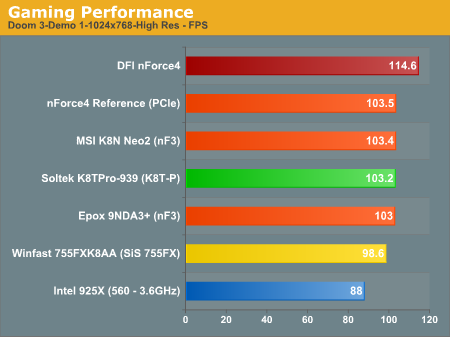

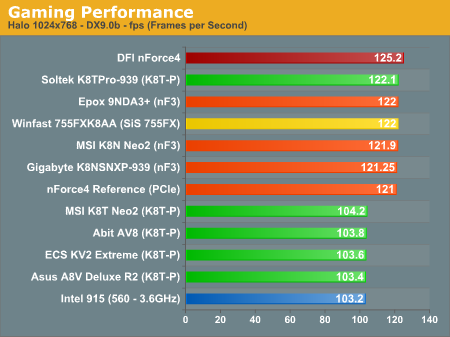
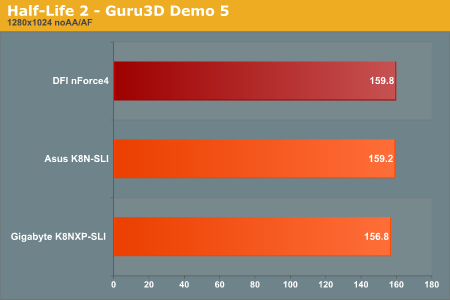
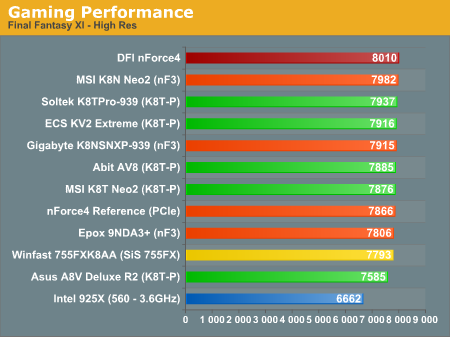

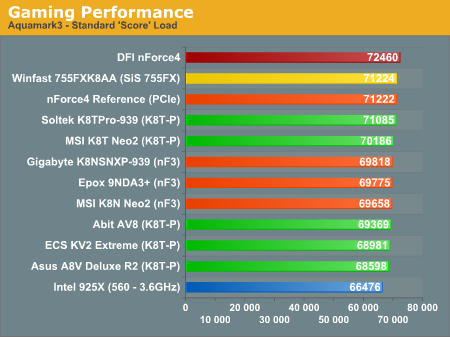
How much praise do you heap on a board that tops all the DirectX 9 benchmarks and also tops every overclocking test that we have run? The DFI nForce4 boards are both exceptional performers at stock as well as incredible overclockers.
Those looking for SLI benchmarks should take a look at test results in Morphing nForce4 Ultra into nForce4 SLI. For SLI to have a major impact on gaming performance, the driver needs to be optimized for SLI. In the Ultra to SLI article, we have compared 3 games that are supported by the current SLI driver, and all 3 show tremendous performance gains with SLI. We are currently working on an SLI roundup that will compare performance of all the current nForce4 SLI boards. That roundup should be posted next week.
DirectX 8 & OpenGL Gaming Performance
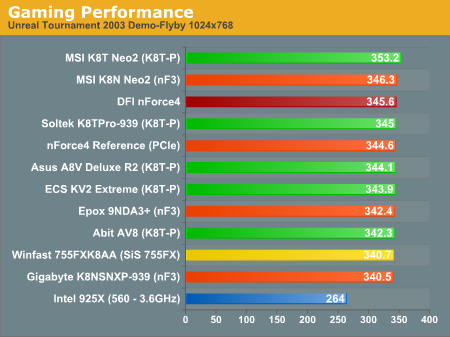
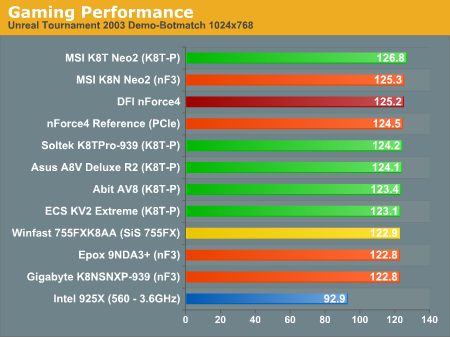
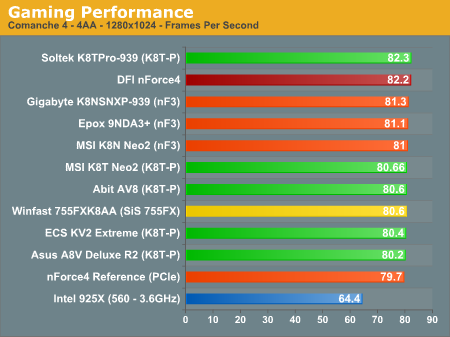


The DFI nForce4 boards continue their outstanding performance in gaming benchmarks. In almost every benchmark, we find the DFI at the top or near the top in performance. Those who will never overclock will be very happy with the performance of the DFI. Enthusiasts will be pleased to see outstanding performance both at stock speeds and in record-breaking overclocking.
Workstation Performance

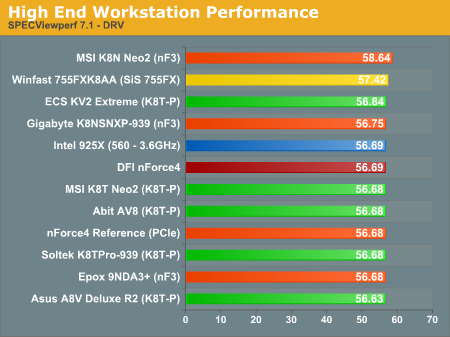
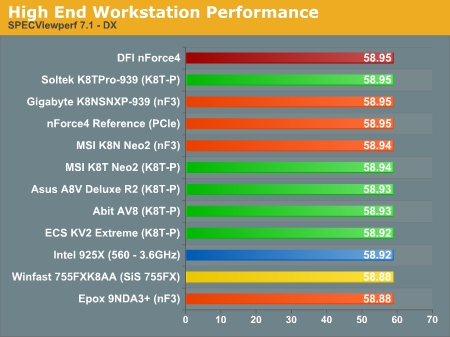
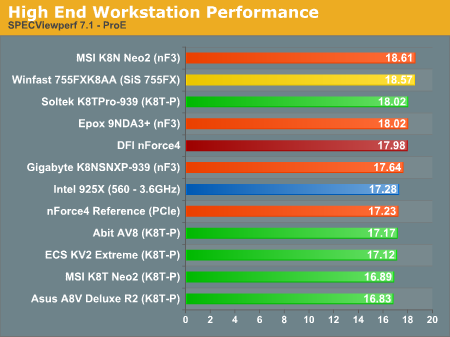

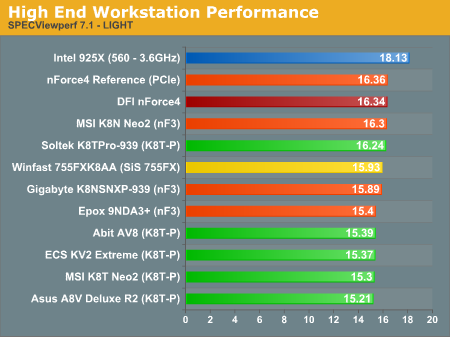
Boards that are tweaked for best overclocking performance often do poorly in workstation benchmark testing. It is satisfying to see that the DFI nForce4, which is clearly an enthusiast overclocking board, also performs well above average in Workstation benchmarks compared to other nForce boards.
Final Words
DFI set out to create the absolute best nForce4 boards that an enthusiast could find on the market. After spending several weeks with engineering samples and now the final retail boards, we believe that DFI has succeeded in their goal. There are other very good nForce4 boards that compete well at stock speeds, overclock well, or perform well in SLI mode, but no other board that we are aware of does so many things so well as the DFI LANParty nForce4 boards. Looking at the boards as they ship, it would be hard not to be impressed with the feature sets, performance, record-setting overclocking, and stability of the new DFI nForce4 motherboards.
If you then throw in the fact that all the DFI nForce4 boards from the $140 UT Ultra-D to the $200 LANParty nF4 SLI-DR are based on the same PCB and use the same BIOS, the story becomes even more interesting. Those simple facts mean that all of the DFI boards perform the same, overclock the same, and contain the same pair of x16 PCIe slots. This allows even the bottom-of the-line Ultra-D to run 2 PCIe video cards in x16/x2 mode at about 90% the performance of full-blown SLI. Perhaps even more impressive is that a simple mod with a #2 pencil turns the Ultra-D into an SLI board, allowing any nVidia drivers to work in full x8/x8 SLI mode. When this is factored into the formula, we have to say that no current nForce4 board - SLI or Ultra - can deliver the value that you get with the DFI LANParty UT Ultra-D.
For many buyers, the UT Ultra-D will be the start and end of their search. A $140 board that performs like this one does, overclocks like this one does, and that also can do SLI is an incredible bargain in today's market. Keep in mind, however, that the price spread from the Ultra-D to the SLI-DR is only about $60 once the prices settle down. Those who are afraid to mod may find the additional $60 for the SLI-DR to be well worth the cost. You also get a full-blown LANParty package with the top board, and the Front-X box, UV cable sheathing and carrying harness for your system do add value.
Last, but clearly not least, the overclocking results will put a smile on any user's face. Memory voltage to 4.0V, the huge array of voltage adjustments, a slew of memory tweaking options, and vCore to 2.1V are all impressive features, but they are even more impressive when they really do enable higher overclocks. On the DFI nF4 boards, that is certainly the case. We reached 318x9 at 1T Command Rate - performance that demolished our previous best of 295 1T with this same memory. We also were able to reach the highest overclock that we have ever seen at stock ratios with our 4000+ CPU, reaching a stable 238x12. Enthusiasts will love this board, and the designers deserve our admiration for the solid design work that went into the DFI nF4 series.
This does not mean that the DFI nForce4 boards are perfect, but they are certainly close. We could wish for High Definition audio on the Karajan Audio Module, and we might wish for an easier means to switch from "normal" to "SLI" mode on the boards. The 6 jumper blocks are clumsy to set to SLI, even with the included chip extractor. But if jumpers were the trade-off to give us an SLI selection on the Ultra-D, we will take them. We also wish that DFI could find some means of reaching an agreement with nVidia to provide the "dual-video" bridge with the Ultra boards. In the larger scheme of things, however, these are mostly minor complaints.
It is rare that we test a board and feel completely satisfied, but to be honest, that is exactly the feeling that the DFI nF4 boards leave with us. Yes, there are a few warts, but the complexion is much clearer of imperfections than we usually find. This is one motherboard that has just earned a spot in my personal setup and it will take something very special to displace this one. This board is a keeper - whether you mod the $140 Ultra-D or spring for the full-blown SLI-DR!







